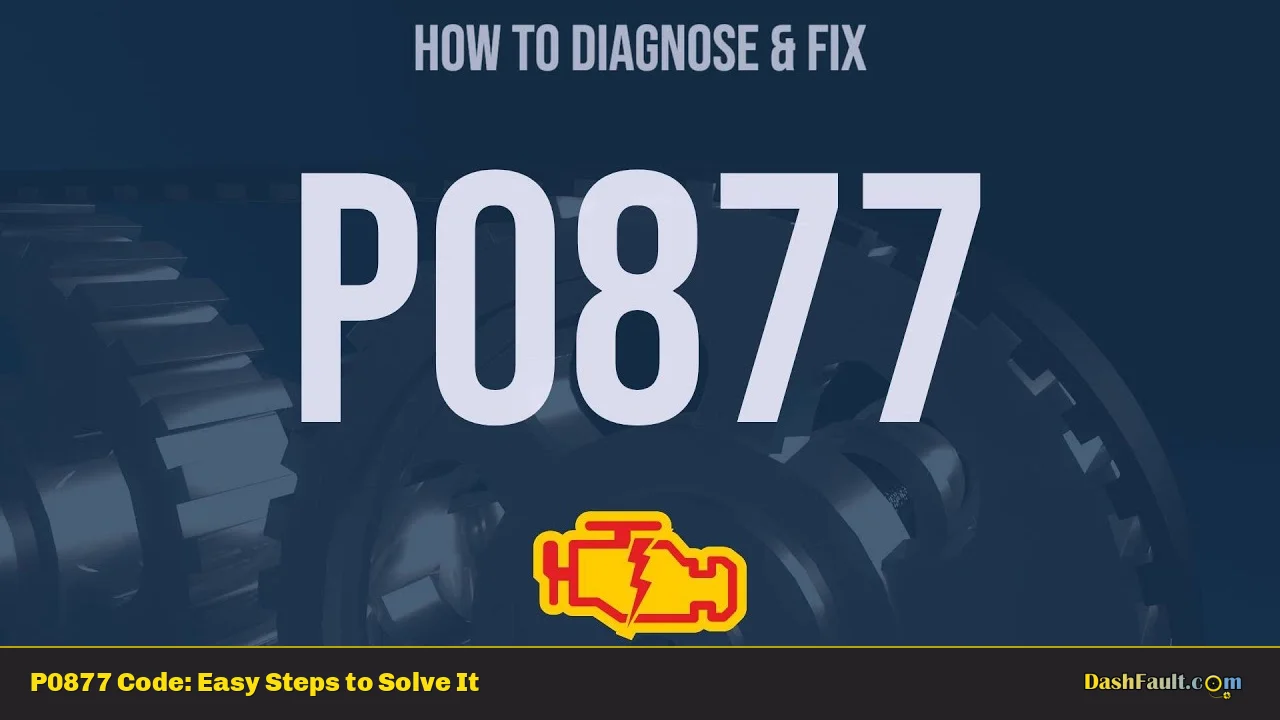The P0877 trouble code is a diagnostic trouble code (DTC) indicating an issue with the Transmission Fluid Pressure Sensor/Switch “D” Circuit Low. This code is triggered when the powertrain control module (PCM) detects that the electrical signal from the transmission fluid pressure sensor is below the expected range. This can lead to various transmission performance issues, making it essential for vehicle owners and DIY mechanics to understand its implications and how to address it.
| P0877 Code Meaning | P0877 Code Common Causes |
|---|---|
| Transmission Fluid Pressure Sensor/Switch “D” Circuit Low | Faulty Transmission Fluid Pressure Sensor |
| Low transmission fluid level | Damaged wiring or connectors in the circuit |
| Transmission overheating | Faulty Powertrain Control Module (PCM) |
| Internal transmission issues | Corrosion at electrical connections |
| Short circuit in the signal circuit | Contaminated or burnt fluid |
Symptoms of P0877 Code
When the P0877 code is triggered, vehicle owners may experience a variety of symptoms, including:
- Check Engine Light: The most common indication that something is wrong.
- Transmission Slipping: Difficulty in shifting gears or unexpected changes in gear.
- Limp Mode Activation: The vehicle may enter a reduced power mode to protect the engine and transmission from damage.
- Unusual Transmission Behavior: This can include harsh shifting or delayed engagement when shifting into gear.
Technical Explanations
The P0877 code relates specifically to the Transmission Fluid Pressure Sensor, which monitors the hydraulic pressure within the transmission. The PCM uses this data to optimize shifting and overall transmission performance. When the sensor detects a low voltage signal, it indicates that the pressure is either too low or that there is an issue with the sensor itself or its wiring.
The transmission fluid pressure sensor operates on a 5-volt reference signal from the PCM. As fluid pressure changes, so does the resistance in the sensor, affecting the voltage signal sent back to the PCM. If this voltage falls outside of specified parameters, the P0877 code is set.
Step-by-Step Diagnosis
Diagnosing a P0877 code involves several steps:
- Check Transmission Fluid Level: Ensure that the transmission fluid is at the correct level and in good condition. Low or burnt fluid can lead to incorrect readings from the sensor.
- Inspect Wiring and Connectors: Visually inspect all wiring and connectors leading to the Transmission Fluid Pressure Sensor for signs of damage, corrosion, or loose connections.
- Test Sensor Voltage: Using a digital voltmeter, check for proper voltage at the sensor’s connector while turning on the ignition (without starting). You should see around 5 volts.
- Check Ground Connection: Ensure that there is a good ground connection for the sensor.
- Resistance Testing: Measure resistance across the sensor terminals according to manufacturer specifications. If readings are outside of specifications, replace the sensor.
- Scan for Additional Codes: Use an OBD-II scanner to check for other related trouble codes that might indicate broader issues with the transmission system.
Solution Methods
To resolve a P0877 code, consider these potential solutions:
- Fluid Change: If fluid condition is poor or low, change it using manufacturer-recommended fluid.
- Sensor Replacement: If tests indicate a faulty sensor, replace it with an OEM (Original Equipment Manufacturer) part.
- Repair Wiring Issues: If damaged wires or connectors are found, repair or replace them as necessary.
- PCM Reprogramming: In rare cases where PCM failure is suspected after other components have been checked, reprogramming or replacement may be needed.
Cost Estimates
The cost of repairs related to a P0877 code can vary widely based on several factors:
- Transmission Fluid Change: $100 – $200 depending on labor rates and fluid costs.
- Sensor Replacement: Parts typically range from $50 – $150 with labor adding another $100 – $200.
- Wiring Repairs: Costs can vary significantly based on damage extent but expect around $100 – $300 for labor and parts combined.
- PCM Replacement/Reprogramming: This can be more expensive, ranging from $400 – $1,200 depending on vehicle make and model.
Warnings and Recommendations
- Always ensure you are using OEM parts when replacing components related to transmission systems to avoid compatibility issues.
- If you are not confident in your ability to diagnose or repair issues related to this code, seek professional help. Transmission systems are complex and require specialized knowledge for effective troubleshooting and repair.
- Ignoring a P0877 code can lead to severe transmission damage over time, resulting in costly repairs or even complete transmission failure.
Frequently Asked Questions About P0877
- What does P0877 mean?
P0877 indicates that there is a problem with the Transmission Fluid Pressure Sensor/Switch “D” Circuit being too low. - Can I drive my car with a P0877 code?
While it may be possible to drive short distances, it is not advisable as it can lead to further transmission damage. - How do I reset a P0877 code?
You can reset it by disconnecting your vehicle’s battery for several minutes or using an OBD-II scanner. - What causes low transmission fluid pressure?
Causes include low fluid levels, overheating, leaks, or faulty sensors. - Is P0877 serious?
Yes, it should be addressed promptly as it can lead to significant transmission problems if ignored. - How much does it cost to fix a P0877 code?
The cost can range from $100 for fluid changes up to $1,200 for PCM replacement. - Can I fix this myself?
If you have mechanical experience and tools, many aspects of diagnosing and fixing this issue can be done yourself. - When should I seek professional help?
If you are unsure about any steps in diagnosing or repairing your vehicle’s transmission system, consult a professional mechanic.
In conclusion, understanding and addressing the P0877 trouble code promptly is crucial for maintaining your vehicle’s performance and longevity. By following proper diagnostic procedures and being aware of potential causes and solutions, vehicle owners can effectively manage this issue and prevent further complications down the line.
